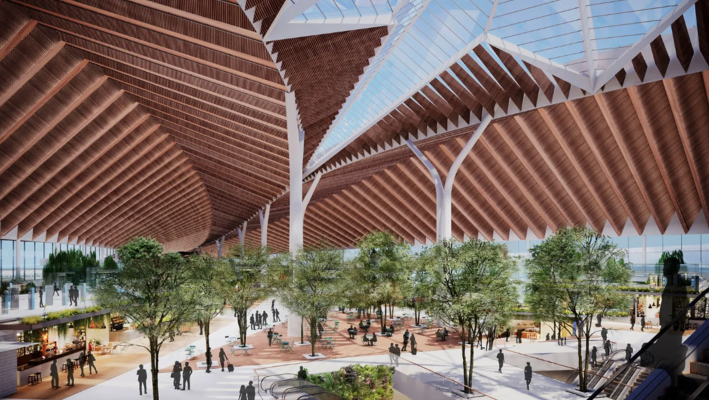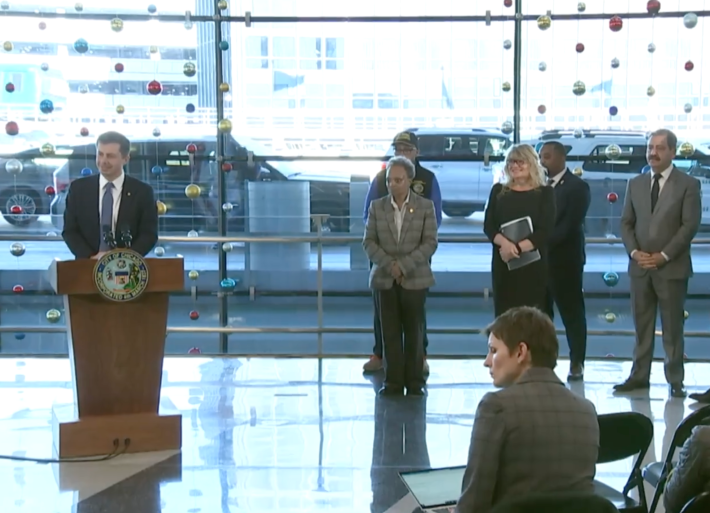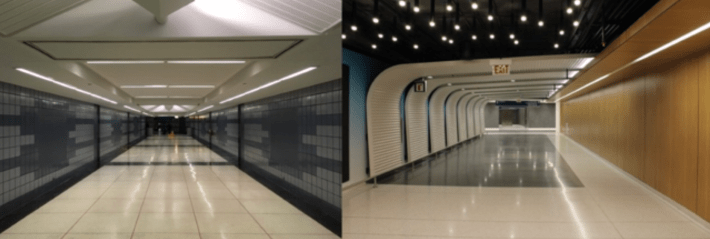In the future there will be even more reason to ride the (hopefully fully rehabbed) CTA Blue Line to Chicago's O'Hare International Airport. Today U.S. transportation secretary Pete Buttigieg joined local officials at the aviation hub to announce that the feds have green-lighted the $12.1 billion Terminal Area Plan modernization and expansion project. The city also provided updates on some walking, transit, and, unfortunately, driving projects at the airport.
The terminal initiative will be one of the largest infrastructure projects in Chicago history. After conducting an environmental review, the Federal Aviation Administration issued its finding there will “no significant impact” on air and water quality or noise, and the project won't cause major air traffic problems. That means construction can start on two new satellite concourses and the new O’Hare Global Terminal, which will replace Terminal 2, plus other related projects.
“Chicago’s transportation infrastructure is what makes this city an economic powerhouse of global importance,” said Buttigieg in a statement. “Now, as we prepare to break ground on O’Hare’s newest terminal, Chicago and this entire region will be positioned to grow and create good-paying jobs through the benefits of first-rate infrastructure, beginning with the construction project itself.”
“O’Hare is the lifeblood of Chicago’s economy, directly employing tens of thousands of Illinois residents and bringing more than 70 million passengers to and through our city each year,” Mayor Lori Lightfoot stated. “The next phase of work will expand O'Hare's capacity to serve travelers and improve the customer experience, transforming it into one of the greatest airports of the 21st century.”

The FAA review, which started in 2018, was required by the National Environmental Policy Act. The study found that the terminal project will decrease emissions emissions overall by reducing airplane taxi times.
Construction is slated to start this spring, with the first satellite concourse scheduled for completion in 2027, and work on the second satellite concourse projected to wrap up in 2028. Demolition of Terminal 2, the airport’s oldest passenger facility, will happen in phases. The work is slated to start in 2026, and with the construction of the O’Hare Global Terminal predicted to end by 2030.
Work to build a large tunnel connecting passengers, baggage, and utilities between the Global Terminal and the satellite concourses is expected to start in 2024 with and finish in 2030.
The satellite concourses will include about 1.3 million square feet of gate and amenity space, and will accommodate both narrow and wide-body airplanes.

There was some first-rate Chicago political drama at today's presser as U.S. Congressional rep Jesus "Chuy" Garcia, who sits on the House Infrastructure Committee and is running in the upcoming Chicago mayoral election, stood a few feet away from Lightfoot, but didn't interact with her. Awkward!
A news release about the terminal expansion included updates on several other transportation-related infrastructure projects at O'Hare. On the plus side, in April, the Airport Transit System people-mover re-launched 24-hour service. The system was shut down in January 2019 for repairs and was supposed to reopen that fall, but due to the COVID-19 pandemic, contract disputes, and other snags, partial service wasn't restored until November 2021, a frustratingly long lag time.

In June, the Chicago Department of Aviation reopened seven pedestrian tunnels linking the Main Terminals to the Blue Line and a parking garage with new designs as part of a $35.5 million project.
Regrettably, the CDA has also been spending lots of money on projects to encourage more people to take private cars to the airport. In August, work was completed on a $25.5 million rehab of the airport's 9,300-space Main Parking Garage, a 49-year-old facility.
And in June the aviation department kicked off work on a new, six-story parking garage at Terminal 5, which will more than double the amount of short- and long-term car storage at O'Hare. Just what Chicagoland needs: more incentive for people to clog local expressways and pollute the environment by taking automobiles to the airport.





